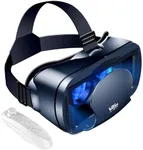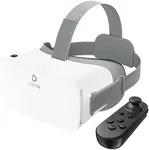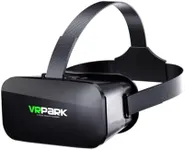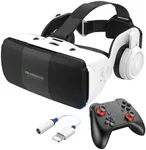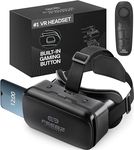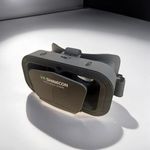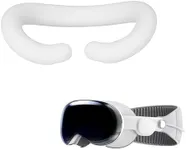Buying Guide for the Best Cell Phone Vr Headsets
Choosing the right cell phone VR headset can greatly enhance your virtual reality experience. It's important to consider various specifications to ensure the headset meets your needs and provides a comfortable and immersive experience. Here are some key specs to look at when selecting a cell phone VR headset.CompatibilityCompatibility refers to whether the VR headset works with your specific cell phone model. This is crucial because not all headsets are designed to fit every phone. To navigate this, check the headset's compatibility list or specifications to ensure your phone is supported. If you have a newer phone, look for headsets that support the latest models. If your phone is older, make sure the headset can accommodate it. Picking the right one for you means ensuring your phone fits securely and the VR experience runs smoothly.
Field of View (FOV)Field of View (FOV) is the extent of the observable world seen at any given moment through the headset. A wider FOV provides a more immersive experience, making you feel like you're truly inside the virtual environment. FOV values typically range from 90 to 120 degrees. For casual users, a lower FOV might be sufficient, but for a more immersive experience, aim for a higher FOV. Your need for immersion should guide your choice here.
Lens QualityLens quality affects the clarity and sharpness of the virtual reality images. High-quality lenses reduce distortion and provide a clearer view. Lenses can be made from different materials, such as plastic or glass, with glass generally offering better clarity. When choosing, consider the lens material and any additional features like anti-reflective coatings. If you plan to use the headset for extended periods, prioritize high-quality lenses to reduce eye strain and enhance your experience.
Comfort and FitComfort and fit are essential for enjoying VR without discomfort. This includes the weight of the headset, the padding, and the adjustability of straps. Lightweight headsets with ample padding and adjustable straps are ideal for long sessions. When navigating options, look for headsets with ergonomic designs and adjustable features. If you plan to use the headset frequently or for long periods, prioritize comfort to avoid strain and ensure a pleasant experience.
Adjustable IPD (Interpupillary Distance)Interpupillary Distance (IPD) is the distance between the centers of your eyes. Adjustable IPD allows you to set the lenses to match your eye distance, which is crucial for a clear and comfortable view. IPD values typically range from 55mm to 75mm. If you have a standard IPD, most headsets will work fine, but if your IPD is outside the average range, look for headsets with adjustable IPD settings. This ensures the best visual experience and reduces eye strain.
Controller SupportController support refers to whether the VR headset comes with or supports external controllers. Controllers enhance the VR experience by allowing you to interact with the virtual environment more intuitively. Some headsets come with built-in controllers, while others support external ones. If you plan to play interactive games or use apps that require precise control, look for headsets with good controller support. Your need for interaction and control should guide your choice.
App and Content AvailabilityApp and content availability refers to the range of VR apps and experiences you can access with the headset. A wider selection of apps and content means more opportunities for entertainment and learning. When choosing a headset, check the platform it supports and the variety of available apps. If you have specific interests, ensure the headset supports apps that cater to those interests. Your preferences for content and experiences should guide your choice.
